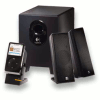- Qualcomm Launches Snapdragon 4 Gen 2 Mobile Platform
- AMD Launches Ryzen PRO 7000 Series Mobile & Desktop Platform
- Intel Launches Sleek Single-Slot Arc Pro A60 Workstation Graphics Card
- NVIDIA Announces Latest Ada Lovelace Additions: GeForce RTX 4060 Ti & RTX 4060
- Maxon Redshift With AMD Radeon GPU Rendering Support Now Available
Logitech X-240 2.1 Music Center Speakers

When Logitech’s X-540 5.1 speaker system came out, it set new standards of performance for the $99 price category. With their new X-240 2.1-channel system, Logitech once again aims to surpass the status quo. With its integrated stand for portable music players and its intelligent electronics, can Logitech manage the same feat again with the X-240?
Page 4 – Listening Tests
For my listening tests, I listened to a variety of music from my collection of 192kHz WMA files spanning the rock and jazz genres, as well as a couple of my favorite reference DVD-audio recordings by Switchfoot and Ben Folds. I also did a little testing of the subwoofer’s range using test tones from a Bass Mekanik test CD.
All audio was passed through a Razer Barracuda AC-1 audio card, based on the excellent C-Media CMI8788 audio chipset. The satellite speakers and wired remote were placed on either side of my monitor, and the subwoofer was placed on the floor behind the desk. Some testing was done with an Apple iPod player.


First, some notes on the performance characteristics of the X-240 system. The X-240 system’s subwoofer provides useful output to about 45 Hz before rolling off sharply in sinewave testing, which suggests the presence of a subsonic filter. However, this subwoofer’s strongest, cleanest output is in the neighborhood of 60-100 Hz.
I also noticed a “thudding” quality to this subwoofer’s output, which may improve the perception of “slam”, but really can’t compete with the true, uncolored bass response that a larger subwoofer can provide. This may be due to the X-240 subwoofer’s high crossover frequency , which is likely in the neighborhood of 180-200Hz.
This subwoofer was easily located by my ears, so you’ll want to consider sub placements that limit a direct transmission path to your ears. My suggestion is to place this subwoofer under or behind your desk. Of course, the short cables will prevent you from placing the subwoofer too far away from the main speakers.
During sine tests at lower bass frequencies, whenever the volume was just a bit too high, the sub’s automatic bass equalization circuitry (which functions as a limiter at high output levels) began to freak out, causing a “helicoptering” sound as the bass equalization circuitry attacked and released repeatedly. This is what happens when the release time parameter of the compression circuit is too short. This issue didn’t seem to affect music playback, however.
With some music that had sustained, loud bass notes, I also noticed a barely-perceptible “surging” effect, which occurred when the limiter attacked the initial transient and then released, allowing the bass level to suddenly rise. Cranking the system’s level to its maximum predictably resulted in a very thin, lean tonal balance, as the limiter held the subwoofer within the limits of its own output capability while the satellites shrieked.
Overall, however, at normal listening volumes the effect of the limiter is a positive one, keeping this tiny subwoofer somewhat more clean and “tight” than most small subs in this price range.
The satellite speakers’ performance was decidedly so-so, even as PC speakers are concerned. Their output was relatively free of any ear-piercing upper-midrange peaks, and decently extended in the top end. However, they suffer from what I call TV-Speaker Syndrome, which occurs when a midrange-producing speaker driver is mounted in a thin-walled plastic enclosure.
The midrange-frequency waves excite the plastic enclosure, lending a resonant, “cupped” character to the midrange, and impairing these speakers’ ability to render midrange detail. The treble response of the 2″ drivers sounds as though it achieves its extension through the use of equalization – the upper-end detail isn’t quite as clear as it is in two-way satellite speakers with a separate tweeter.
On a positive note, the satellites demonstrated decent stereo imaging, which refers to the audible placement of sound sources in space. As with the small subwoofer, these satellites put the X-240 system on par with the other offerings in this price range.
|
|
Support our efforts! With ad revenue at an all-time low for written websites, we're relying more than ever on reader support to help us continue putting so much effort into this type of content. You can support us by becoming a Patron, or by using our Amazon shopping affiliate links listed through our articles. Thanks for your support!






